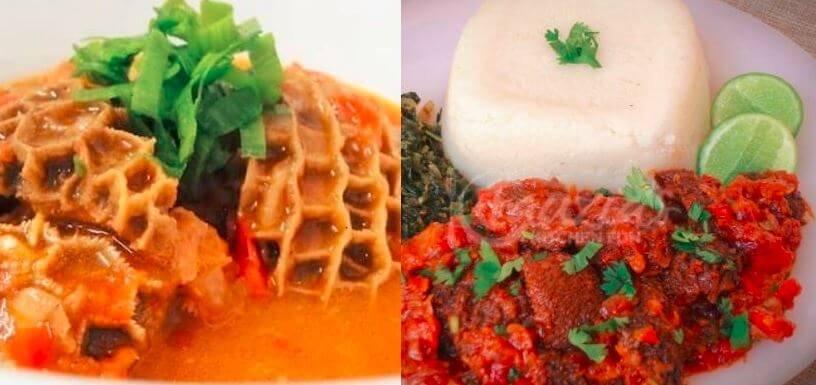Matumbo (tripe in English) is one of the delicious but neglected meals in Kenya. Many people despise Matumbo as they deem it hard to effectively prepare the meal. Are you among the people who find it hard to prepare Matumbo food? If so, we shall make this easy for you through this article. Just keep reading and if possible, prepare a pen and paper to take notes. You will be able to prepare delicious, yummy, and tasty thyme habanero Matumbo after reading this post.
I am a lover of Kenyan Matumbo. Nothing will stop me from eating Matumbo especially with Managu, hot ugali, and traditional mala!. Am already salivating as I write this due to the memories of this delicacy. After covering how to prepare delicious mtura, our readers wanted to know the procedure for cooking matumbo. here it is now!
Let me take you through the processes of preparing Matumbo food.
Ingredients

We are going to prepare Matumbo for 5 people. Here are the ingredients you’ll need:
- 1 large diced red onion
- 1 large grated tomato
- A bunch of dhania (both leaves and stems will be used)
- 2.5 kgs of Matumbo
- ½ teaspoon of tyme
- ½ teaspoon of habanero
- 1 teaspoon of royco
- Salt
- Vegetable oil (I prefer Ghee or butter)
- 1 tablespoon tomato paste
- ½ a cup of maziwa mala
- 3 garlic cloves
Cooking Method
Cleaning method
This is the hardest task and is the reason many people avoid cooking Matumbo. However, because we are Matumbo food lovers, we have to do it anyway. I prepare using a basin instead of washing directly from the sink.
How to clean Matumbo

- Put the matumbo in a basin and add water (For the towel-like matumbo, no need to add water first). If you are cooking the towel-like matumbo, just add enough salt and start squeezing it as much as possible. It’s recommended to peel the outer layer to make them tender and shorten the cooking time. After squeezing, you can now add water and start washing.
- For the soft matumbo (the one with many pockets) you have to add water first and wash thoroughly.
- It’s recommened to use a spoon or cooking stick to clean inside the matumbo pipes as you squeeze it. On the contrary, you can open up the pipes by slicing through the matumbo with a knife. This gives you access to clean inside the pipes.
- After removing all the inside dirt, start rinsing the matumbo. You should do this thoroughly as you change the water until you can get clean water.
If you want to know that your matumbo is clean enough, it should not slide as you try cutting it. From there, we can move to the second step below:
Boiling
Matumbo should be boiled until they are tender. Remember, you want this meal as sweet and yummy as possible, therefore, it should not be hard. In my case, I normally use a charcoal jiko and this takes me about 5 hours boiling the matumbo until it’s tender. However, this will depend on the amount of matumbo you are boiling. You cant boil ½ kg of matumbo for that long.
It can be better to use a pressure cooker as this will take less time compared to a jiko. As you cook, keep checking to ensure they don’t turn into shreds.
Frying the Matumbo

After boiling, it’s time to fry our matumbo. This will depend on your preferences whether you want it wet fried or stewed. Follow the steps below:
- Cut your red onion, garlics, thyme, tomato, and dhania stems (pull off dhania leaves for later use). You can crush the garliic instead of cutting it.
- Put your cooking oil on a sufuria according to the amount you prefer. Add garlic and onion and cook until they start turning brown. Add tomato and thyme then cook for about 5 minutes until you get a paste. I love using fresh thyme but you can buy the powdered one in the supermarket.
- Add dhania and chili (I use fresh yellow habanero). You can as well use the packaged habanero bought from the supermarket. I am a team ‘natural’ so dont worry why I use natural ingredients in cooking.
- Add your already boiled matumbo and stir well to mix. You can add water according to your preference. I love wet-fried matumbo so at this point, i just add a little water.
- Cook for about 20 minutes under medium heat then add your maziwa mala (I like using the naturally-fermented milk). We add maziwa mala to get a thick stew and to temper the heat f the habanero chili.
- Add dhania leaves at this point. Allow these to cook for about 5 minutes under medium heat.

Your Matumbo is now ready for serving. you can take it with Chapati or Ugali as you love. Try using this recipe to make your matumbo and comment under the comment section below. I want to know how you feel after using my approach to prepare Matumbo food.
Matumbo Nutritional Value
Most people tend to claim that matumbo does not have any nutritional value. That’s a lie and a misconception that should be ignored. My primary school science teacher taught me that living things and parts of their bodies are sources of protein. Matumbo is part of the body of living organisms (cow, goat, sheep, chicken). Therefore, matumbo are rich in protein and other essential nutrients for the body.
Moreover, matumbo are high in vitamins. If you want a good source of vitamin B12, then your go-to source is matumbo. Vitamin B12 is good for skin, hair, and also boosts the immune system due to the presence of zinc and phosphorus.
Final Thoughts
Matumbo is one of the cheapest animal organ and protein sources in Kenya. It’s cheap because of the low demand as many people consider it cumbersome to prepare. However, I am sure you have learned how easy it is to prepare yummy matumbo from this post. I hope you will put this guide into practice and prepare some matumbo for your family and friends. After doing that, please leave a comment below on how delicious it was. You can as well share this post with your friends and relatives so they can also learn how to prepare matumbo. Just click the social media buttons below to share the post!







